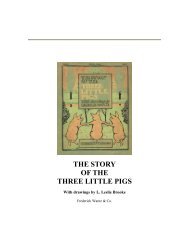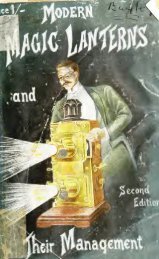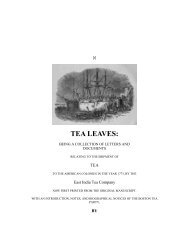54<strong>of</strong> old tubing (shown tinted in drawing) <strong>and</strong> if a Y piece is not to h<strong>and</strong> tocarry the supply to the <strong>lantern</strong> from two burners, tie a knot in the oddpiece, leaving one open for the supply tube. It is always best to use aT or Y piece, it gives a much better supply. Be sure <strong>and</strong> remove theburner first before putting on tubing which supplies the <strong>lantern</strong>.Fig. 31-CONDENSERS.<strong>The</strong> object <strong>of</strong> a lens which is termed a condenser, is to take up aswide an angle <strong>of</strong> light as possible from the illuminant, be it oil, or limelight,<strong>and</strong> so cone it down in such a manner, as to pass it through theobjective, or front lens, which it does by refraction, wider the refractiveangle, shorter the focus, <strong>and</strong> consequently the shorter the focus <strong>of</strong>condenser, greater the light on the screen. This can be done with asingle condenser, only that the lens would require to be <strong>of</strong> such athickness, that much light is lost by absorbtion, <strong>and</strong> the chromatic <strong>and</strong>spherical aberration would also be very great, the disc appearing unevenwith a fringe <strong>of</strong> colour around the edge. <strong>The</strong> use <strong>of</strong> two lenses <strong>of</strong>moderate thickness accomplishes the desired result, <strong>and</strong> minimizesthe aberration.Condensers have been made in various forms <strong>and</strong> curvatures fromsingle bull's-eye, to the present triplet.Previous to the introduction <strong>of</strong> photographs, when slides were entirelypainted by h<strong>and</strong>, it was the rule to have the slides from six to eightinches in diameter, for the obvious reason, that more detail could bel)ainted in an eight inch circle than in a three inch picture. With thesethe
55large slides it was necessary to have large condensers <strong>of</strong> eight to teninches in diameter, which were <strong>of</strong> very long focus <strong>and</strong> badly cut.At the present time we are enabled to use a 3in.much finer result.picture, <strong>and</strong> obtain a<strong>The</strong> st<strong>and</strong>ard size slide is now 3^^ x 3^^, <strong>and</strong> the circle <strong>of</strong> the saidslide 3ins., now if this was always the case, <strong>and</strong> circular mats were alwaysused in slides, a 3|in, condenser would suffice, as it is, slides are mountedwith square <strong>and</strong> cushion shaped mounts, <strong>and</strong> it is thus requisite to have acondenser <strong>of</strong> 4in. diameter, so as to take in the corners <strong>of</strong> the squareslide. With a condenser larger than this there is a great loss <strong>of</strong> light,unless slides are used <strong>of</strong> a larger size in proportion, <strong>and</strong> front objectiveto match. As little is to be gained by so doing, <strong>and</strong> the extra expenseconsiderable, it is rarely attempted.<strong>The</strong> form <strong>of</strong> condenser which absorbs the most rays, <strong>and</strong> is nowgenerally adopted either in conjunction with lime or oil light is adouble piano convex, mounted with the convex surfaces inward.A piano <strong>and</strong> miniscus mounted together with the miniscus to the light,is a good form for limelight, <strong>and</strong> admits as much <strong>of</strong> the rays as any form,<strong>and</strong> has the advantage <strong>of</strong> being suitable for long or short focus objectives,being <strong>of</strong> short focus, it necessitates the illuminant being very close to theminiscus lens, <strong>and</strong> if the jet is kept burning for any considerable time,is very apt to crack.For oil light, <strong>and</strong> for use with a short focus objective, a double pianoconvex, as already mentioned is the best form <strong>and</strong> should be <strong>of</strong> very shortfocus. <strong>The</strong> curves <strong>of</strong> a short focus condenser being very acute, it will takeup more <strong>of</strong> the rays outside its axis than a lens <strong>of</strong> longer focus, <strong>and</strong> giveconsiderably more light on the screen than one <strong>of</strong> longer range. Whena lens or objective is used <strong>of</strong> a longer focus than six inches (we refer toback focus) a condenser must likewise be employed <strong>of</strong> a longer focus, ifsquare or cushion shaped slides are used. With circular slides it is notnecessary.If a short focus condenser is used with a long focus, a disc with colour<strong>and</strong> falling away around the edge results. Owing to the extreme outerrays being takenup.If only 3in. circular pictures are used, with the 4in. condenser, theextreme marginal rays are not used, as half an inch all round the slide iscut<strong>of</strong>f. Whenever a square or cushion shape is used, the chromaticaberration makes itself slightly visible at the four corners.Lesson. —A condenser <strong>of</strong> longer focus islens is used, than with a lens <strong>of</strong> shorter focus.necessary when a long focus
- Page 1 and 2:
THEPROJECTIO,MA GIC LANTERN MANUAL
- Page 3:
OCSBLIBRAPY
- Page 7:
..INDEXA.Adjustment of a JclAlumini
- Page 10 and 11:
—increased by the aid of a powerf
- Page 12 and 13:
far back as 1811. Lanterns of the a
- Page 14 and 15:
mixadvisable to have a mahogany, or
- Page 16 and 17:
8A condenser can only take those ra
- Page 18 and 19: There is a considerable difference
- Page 20 and 21: 12occasions, it is only necessary t
- Page 22 and 23: 14Triplexicon was first made it was
- Page 24 and 25: i6aid of two screws. The two slots
- Page 26 and 27: perfection, combustion, and purity,
- Page 30 and 31: 20back of lantern, in that case the
- Page 32 and 33: sumed, the flow should be adjusted
- Page 34 and 35: 24which is passed over the rod, and
- Page 36 and 37: 26gases to be shut off without dist
- Page 38 and 39: 28made in their get up. We have nev
- Page 41 and 42: 3tserve to distribute the same to t
- Page 43 and 44: (V>ao—IH
- Page 45 and 46: ;33the thing a study, and used such
- Page 47 and 48: V>-is:a
- Page 49 and 50: 35who designed the body of this lan
- Page 51 and 52: 37far back but equally flat to the
- Page 53 and 54: 39ceding one, therefore giving grea
- Page 55 and 56: 4tthe same as they do, in fact it i
- Page 57 and 58: —43reducing same as low as possib
- Page 59 and 60: 45With all three discs, as coincide
- Page 61 and 62: 47and the slides may be placed in a
- Page 63 and 64: 49inch and inch and-a-half screws,
- Page 65 and 66: SIshowing, gently push back the cov
- Page 67: 53sun rising and illuminating the p
- Page 71 and 72: 57A. Is a right angle prism, being
- Page 73 and 74: 59small diameter as through an obje
- Page 75 and 76: —6isize of disc can be produced.
- Page 77 and 78: —63COMPRESSED GASES.Compressed ga
- Page 79 and 80: 6sNO DANGER WITH GAS CYLINDERS,OR B
- Page 81 and 82: "67valves are of little use as a me
- Page 83 and 84: 69to reach our compressors without
- Page 85 and 86: ——71ascertain their bursting po
- Page 87 and 88: —73bottles black, and hydrogen (o
- Page 89 and 90: ;Having blown through every tube to
- Page 91 and 92: 77controlling the flow of compresse
- Page 93 and 94: 79The Duplex.—The chieffeaturecon
- Page 95 and 96: —8icarries the gas to the orifice
- Page 97 and 98: 83the above-mentioned tube, whilst
- Page 99 and 100: 8sTable for Ascertaining the Quanti
- Page 101 and 102: 87On no account use two separate bo
- Page 103 and 104: 89virtue, and if required to be use
- Page 105 and 106: 91In finishing up, turn out the hgh
- Page 107 and 108: 93good support in one sense— but
- Page 109 and 110: 95another takes its place without a
- Page 111 and 112: 97opposite side to that which he is
- Page 113 and 114: 99without doubt, this is the only t
- Page 115 and 116: lOIFig 56.SCREEN FRAMES.Considerabl
- Page 117 and 118: I03and hauled up. The pulley blocks
- Page 119 and 120:
PRACTICAL HINTS TO INTENDING LECTUR
- Page 121 and 122:
107as well as the lecturer, a syste
- Page 123 and 124:
109Fig. 57- Fig. 58.READING LAMP.A
- Page 125 and 126:
oils have to be substituted simply
- Page 127 and 128:
1^3Fig. 54.A cheap but none the les
- Page 129 and 130:
115Directions.— Having thoroughly
- Page 131 and 132:
117objectives which will not give s
- Page 133 and 134:
119is immersed, then as the water e
- Page 135 and 136:
12Ireadily splits up by cleavage) a
- Page 137 and 138:
123particular kind of structure und
- Page 139 and 140:
125the complementary colour to red
- Page 141 and 142:
127of a combined microscope and pol
- Page 143 and 144:
129without this defect is well nigh
- Page 145 and 146:
131diameter, and focus, the general
- Page 147 and 148:
133The loss of light is not so grea
- Page 149 and 150:
135cheap as circular pattern, but t
- Page 151 and 152:
^37A variety of subjects may be tre
- Page 153 and 154:
—139on an average far superior re
- Page 155 and 156:
—141development, immerse in the f
- Page 157 and 158:
143Hydrokinone.Solution I. Solution
- Page 159 and 160:
—145Add r drop of solution of Bro
- Page 161 and 162:
147crystal varnish, some red sable
- Page 163 and 164:
149boiled oil to the medium. Perfec
- Page 165 and 166:
;151sienna to impart warmth without
- Page 167 and 168:
iS3front glass injuring the paintin
- Page 169 and 170:
155Fig 73-Fig 74.handle to which th
- Page 171 and 172:
;157follows :—one end of the fram
- Page 173 and 174:
159on any slide providing it is dar
- Page 175 and 176:
i6iTrough, which consists of two gl
- Page 177 and 178:
—i63It is advisable to fill the t
- Page 179 and 180:
i65matter on the surface of the pur
- Page 181 and 182:
—167planation we have indicated i
- Page 183 and 184:
169single light box is very mislead
- Page 185 and 186:
ADVERTISEMENTS.
- Page 187 and 188:
ADVERTISEMENTS. 173HAZELL, WATSON,
- Page 189 and 190:
ADVERTISEMENTS.I75Brilliant Effect.
- Page 191 and 192:
;ADVERTISEMENTS.ILIFFE & SOIL'SP HO
- Page 193 and 194:
ADVERTISEMENTS. 179ENORMOUS SUCCESS
- Page 195 and 196:
ADVERTISEMENTS.HUGHES' NEW PATTERN
- Page 197 and 198:
ADVERTISEMENTS. 183RussianJronJLamp
- Page 199 and 200:
TheADVERTISEMENTS. 185THE GRIND BIU
- Page 201 and 202:
nothingADVF.RTISE^[E^TS.iS7HUGHES'H
- Page 203 and 204:
THE MINIATURE MALDEN TRIPLE.HUGHES'
- Page 205 and 206:
No. 1 Lantern.THE: UNIVERSALMAGICLA
- Page 207 and 208:
!ADVERTISEM ENTS.Hughes' Special Pa
- Page 209 and 210:
:ADVERTISEMENTS. 191To Lecturers an
- Page 211 and 212:
ADVERT iSF.MENTS.1^3I^ ANTERNNEGATI
- Page 213:
ENGLANDSLANTERNAREPLATESUNSURPASSED
- Page 217:
A 000 618 714





